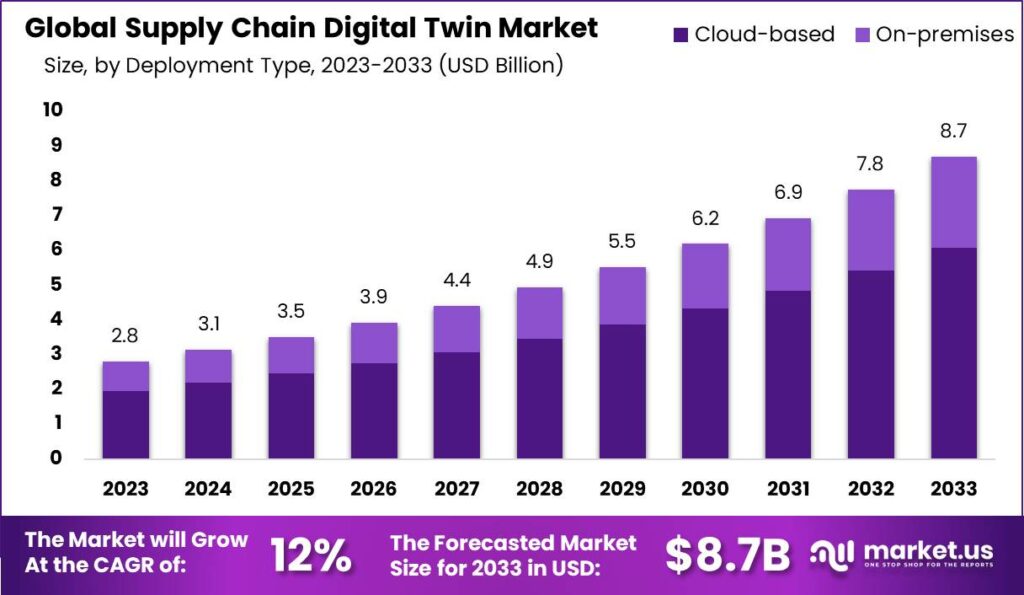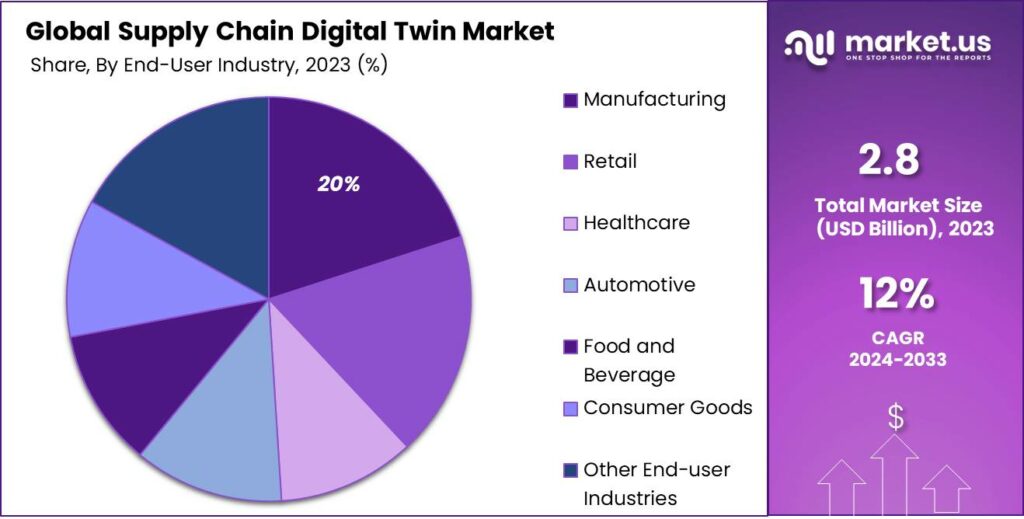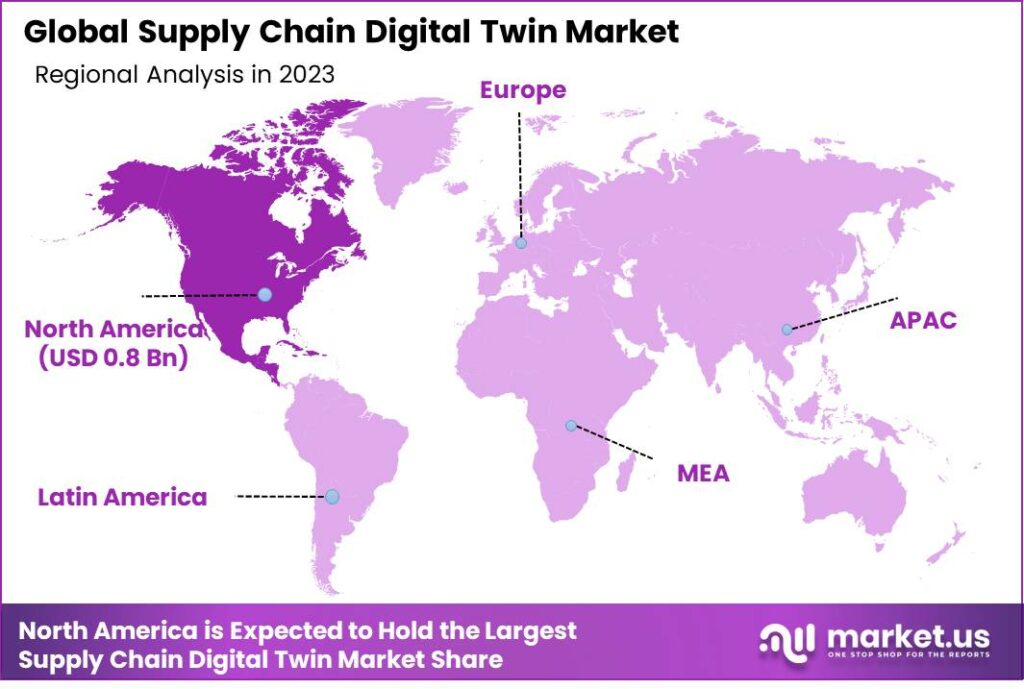New York, Jan. 22, 2024 (GLOBE NEWSWIRE) -- According to Market.us, The Worldwide Supply Chain Digital Twin Market is projected to reach a substantial valuation of USD 8.7 billion by the year 2033, displaying a noteworthy Compound Annual Growth Rate (CAGR) of 12.0% during the forecast period from 2024 to 2033.
Supply Chain Digital Twin refers to a virtual replica or simulation of a physical supply chain, created using real-time data and advanced technologies such as the Internet of Things (IoT), artificial intelligence (AI), and machine learning (ML). By leveraging real-time data, advanced analytics, and simulation capabilities, a Supply Chain Digital Twin enables organizations to better understand, analyze, predict, and optimize their supply chain processes.
The market for Supply Chain Digital Twins is a segment within the broader field of digital transformation and supply chain management technologies. It encompasses the development, provision, and implementation of digital twin solutions specifically for supply chain applications. The growth in this market is driven by the increasing complexity of supply chains, the need for greater visibility and control, and the rising demand for predictive analytics in supply chain management.
Click to Request Sample Report and Drive Impactful Decisions: https://market.us/report/supply-chain-digital-twin-market/request-sample/

Supply Chain Digital Twin Market Statistics
- The Global Supply Chain Digital Twin Market is projected to reach a value of USD 8.7 billion by the year 2033, with a noteworthy compound annual growth rate (CAGR) of 12.0% expected from 2024 to 2033.
- In 2023, the Software segment held a dominant market position, capturing over 65% of the market share.
- Cloud-based deployment mode emerged as the dominant player, with over 70% market share in 2023.
- In 2023, the Internet of Things (IoT) segment held a dominant market position in the Supply Chain Digital Twin market, capturing more than a 30% share.
- Large Enterprises dominated the market, accounting for more than 65% of the market share in 2023.
- The manufacturing sector emerged as the dominant end-user industry, capturing over 20% of the market share in 2023.
- North America leads in the supply chain digital twin market, with a significant market share of over 32% in 2023. The region benefits from technological innovation, a well-established logistics sector, and a supportive regulatory environment.
Factors Affecting the Growth of the Supply Chain Digital Twin Market
- Technological Advancements: The continuous evolution of technologies such as the Internet of Things (IoT), artificial intelligence (AI), and cloud computing directly impacts the growth of this market. These technologies enable more sophisticated and comprehensive digital twin solutions.
- Increasing Complexity of Supply Chains: Globalization and the expansion of e-commerce have made supply chains more complex. Companies are turning to digital twins for enhanced visibility and decision-making support.
- Need for Risk Management: In an era of frequent disruptions, such as pandemics or geopolitical tensions, the ability to simulate different scenarios and plan for contingencies is crucial. Digital twins facilitate advanced risk assessment and mitigation strategies.
- Demand for Real-time Data and Analytics: The growing need for real-time insights into supply chain operations to make informed decisions is a key driver for the adoption of digital twin technology.
- Sustainability and Efficiency Pressures: With increasing focus on sustainability, companies are looking for ways to optimize their supply chain operations for energy efficiency and reduced carbon footprint. Digital twins offer a way to simulate and implement more sustainable practices.
- Customization and Customer Expectations: As customer demands for personalized products and services grow, supply chains must become more flexible and responsive. Digital twins allow companies to model and adapt their supply chains more efficiently to meet these evolving needs.
Drive Your Business Growth Strategy: Purchase the Report for Key Insights@ https://market.us/purchase-report/?report_id=107564
"Modern supply chains have become increasingly complex due to global operations, multiple stakeholders, and intricate networks. Supply Chain Digital Twins offer a comprehensive view of the entire supply chain, enabling businesses to understand and manage this complexity effectively. As companies strive for increased visibility, agility, and efficiency in their supply chain operations, the demand for Supply Chain Digital Twins is expected to rise", Says Mr. Yogesh Shinde Team Lead (ICT) @ Market.us
Report Segmentation of Supply Chain Digital Twin Market
Component Analysis
In 2023, the Software segment held a dominant market position in the Supply Chain Digital Twin market, capturing more than a 65% share. This substantial market share can be attributed to several key factors. Firstly, the robust demand for digital twin software is driven by its ability to create a virtual representation of supply chain operations, thereby facilitating enhanced decision-making and predictive analytics. This technology allows businesses to simulate, visualize, and experiment with their supply chain processes in a virtual environment, leading to significant efficiency improvements and cost reductions.
Moreover, the increasing integration of advanced technologies such as AI, machine learning, and IoT within supply chain management has further amplified the need for sophisticated software solutions. These integrations enable real-time monitoring and analysis of supply chain activities, ensuring a more responsive and agile operation. The growing emphasis on supply chain resilience and risk mitigation, especially in the wake of global disruptions like the COVID-19 pandemic, has also spurred the adoption of digital twin software.
Deployment Mode Analysis
In 2023, the Cloud segment held a dominant market position in the Supply Chain Digital Twin market, capturing more than a 70% share. This dominance of the cloud-based deployment mode can be primarily attributed to its scalability, flexibility, and cost-effectiveness. Cloud platforms offer unparalleled access to advanced computing resources without the need for substantial upfront capital investments, making them a preferred choice for businesses of all sizes. This is particularly relevant in the context of supply chain management, where the ability to quickly adapt and scale operations is crucial.
The proliferation of cloud computing has also enabled more robust data analytics and integration capabilities. With cloud-based digital twins, companies can seamlessly aggregate and analyze data from various sources, including IoT devices, to gain real-time insights into their supply chains. This leads to enhanced operational efficiency, improved risk management, and better decision-making.
Get PDF Sample for Technological Breakthroughs@ https://market.us/report/supply-chain-digital-twin-market/request-sample/
By Technology
In 2023, the Internet of Things (IoT) segment held a dominant market position in the Supply Chain Digital Twin market, capturing more than a 30% share. The preeminence of the IoT in this sector is attributed to its foundational role in enabling real-time data collection and connectivity within supply chain networks. IoT technologies are integral to the development of digital twins, as they provide the sensory framework necessary to collect detailed data from various points in the supply chain. This data is crucial for creating accurate and dynamic virtual models of physical supply chain operations.
IoT devices, such as sensors and RFID tags, facilitate continuous monitoring and tracking of goods, equipment, and vehicles. This capability ensures enhanced visibility and control over supply chain processes, leading to improved efficiency, reduced downtime, and better inventory management. Furthermore, IoT technologies enable predictive maintenance and quality control by providing early warning signals for potential disruptions or quality issues, thereby reducing waste and enhancing overall supply chain reliability.
Organization Size
In 2023, the Large Enterprises segment held a dominant market position in the Supply Chain Digital Twin market, capturing more than a 65% share. This significant market share held by large enterprises can be primarily attributed to their greater resources and capacity to invest in advanced technologies. Large enterprises often have complex and extensive supply chain networks that require sophisticated management tools for optimization and efficiency. The adoption of digital twin technology in these organizations is driven by the need to enhance visibility, improve operational efficiency, and reduce risks associated with supply chain disruptions.
The financial robustness of large enterprises enables them to invest in cutting-edge technologies such as Internet of Things (IoT), Artificial Intelligence (AI), and Big Data Analytics, all of which are integral to the effective implementation of supply chain digital twins. These investments are often part of broader digital transformation initiatives aimed at maintaining competitive advantage and meeting evolving market demands.
End-User Industry
In 2023, the Manufacturing segment held a dominant market position in the Supply Chain Digital Twin market, capturing more than a 20% share. This prominence can be attributed to the manufacturing sector's intrinsic complexity and the critical need for precision and efficiency in its operations. Manufacturers face challenges such as managing intricate networks of suppliers and distributors, ensuring timely delivery of materials, and maintaining optimal inventory levels. The adoption of digital twin technology in this sector allows for a sophisticated simulation of these processes, offering real-time insights and predictive analytics to optimize production schedules, reduce downtime, and enhance supply chain responsiveness.
Furthermore, the Manufacturing industry is increasingly focusing on customization and rapid response to market demands. Digital twins facilitate these objectives by enabling manufacturers to model and test different scenarios, thereby improving decision-making and agility. The sector's significant investment in IoT and AI technologies further boosts its dominance in the market. These investments empower manufacturers to integrate advanced sensors and data analytics into their operations, providing a more comprehensive and accurate digital representation of their physical supply chains.

Key Market Segments
By Component
- Software
- Services
Deployment Mode
- On-premise
- Cloud
By Organization Size
- Large Enterprises
- Small and Medium Size Enterprises (SMEs)
By Technology
- Internet of Things (IoT)
- Big Data Analytics
- Artificial Intelligence (AI)
- Blockchain
- Other Technologies
By End-User Industry
- Manufacturing
- Automotive
- Aerospace and Defense
- Retail
- Pharmaceuticals
- Consumer Goods
- Others
Don’t miss out on business opportunities in Market. Speak to our analyst and gain crucial industry insights that will help your business grow: https://market.us/book-appointment/?report_id=107564
Driver: Advancements in IoT and AI Technologies
One of the primary drivers for the Global Supply Chain Digital Twin market is the significant advancements in Internet of Things (IoT) and Artificial Intelligence (AI) technologies. These technological improvements have made it possible to collect, process, and analyze vast amounts of data from various points in the supply chain. The integration of IoT and AI with digital twin technology allows businesses to create highly accurate and dynamic virtual models of their physical supply chain operations, leading to enhanced decision-making, predictive analytics, and operational efficiency. This driver is critical in supporting the continued growth and adoption of digital twin technology in supply chain management.
Restraint: High Implementation Costs and Complexity
A major restraint in the Global Supply Chain Digital Twin market is the high cost and complexity associated with implementing these systems. Setting up a digital twin for supply chain operations often involves substantial investment in terms of both financial resources and time. The complexity of integrating digital twin technology with existing IT infrastructure and the need for skilled personnel to manage and interpret the data can be prohibitive for some organizations, especially small and medium-sized enterprises (SMEs). This restraint poses a significant challenge to the widespread adoption of digital twin technology across all sectors of the market.
Opportunity: Rising Demand for Supply Chain Resilience and Sustainability
An emerging opportunity in the Global Supply Chain Digital Twin market is the increasing demand for enhanced supply chain resilience and sustainability. In light of recent global disruptions, such as the COVID-19 pandemic, and growing concerns about environmental impact, companies are seeking ways to make their supply chains more resilient to external shocks and more sustainable in terms of resource usage. Digital twin technology offers a powerful tool for achieving these goals by enabling companies to simulate and test various supply chain scenarios, optimize resource utilization, reduce waste, and plan for contingencies. This opportunity is expected to drive further innovation and adoption of digital twin technology in the global supply chain sector.
For a better understanding, refer to this sample report, which includes corresponding tables and figures@ https://market.us/report/supply-chain-digital-twin-market/request-sample/
Competitive Landscape
The competitive landscape of the market has also been examined in this report. Some of the major players include:
- Siemens AG
- IBM Corporation
- SAP SE
- Oracle Corporation
- General Electric Company
- PTC Inc.
- Ansys Inc.
- Accenture plc
- Dassault Systèmes
- Cisco Systems, Inc.
- Huawei Technologies Co., Ltd.
- PTC Inc.
- Other Key Players
Scope of the Report
| Report Attributes | Details |
| Market Value (2023) | US$ 2.8 Billion |
| Forecast Revenue 2033 | US$ 8.7 billion |
| CAGR (2024 to 2033) | 12% |
| North America Revenue Share | 32% |
| Base Year | 2023 |
| Historic Period | 2018 to 2022 |
| Forecast Year | 2024 to 2033 |
Regional Analysis
In 2023, North America held a dominant market position in the Supply Chain Digital Twin market, capturing more than a 32% share. This substantial market share can be attributed to several factors unique to the region. North America, particularly the United States, is home to many of the world's leading technology companies and has a robust technological infrastructure. This environment fosters innovation and early adoption of advanced technologies, including digital twin solutions in supply chain management.
The region's focus on enhancing supply chain resilience and efficiency, especially in light of recent global disruptions, has driven significant investment in digital twin technologies. North American companies are increasingly leveraging these solutions to gain a competitive edge by optimizing their logistics, reducing operational costs, and improving their ability to respond to market changes.
Additionally, the presence of a highly skilled workforce and a strong focus on research and development in North America contribute to the rapid advancement and implementation of these technologies. The region's commitment to embracing digital transformation across various industries, including manufacturing, retail, and healthcare, further supports the growth of the digital twin market in the supply chain sector.

By Geography
- North America
- The US
- Canada
- Europe
- Germany
- France
- The UK
- Spain
- Italy
- Russia
- Netherland
- Rest of Europe
- APAC
- China
- Japan
- South Korea
- India
- Australia
- New Zealand
- Singapore
- Thailand
- Vietnam
- Rest of APAC
- Latin America
- Brazil
- Mexico
- Rest of Latin America
- Middle East & Africa
- South Africa
- Saudi Arabia
- UAE
- Rest of MEA
Browse More Related Reports
- Fraud Detection and Prevention (FDP) Market valuation is set to reach USD 2226.0 billion by 2033, projected to increase at 20% CAGR.
- Big data as a Service Market is anticipated to be USD 809.7 billion by 2033. It is estimated to record a steady CAGR of 33.1%.
- E-Commerce Platforms Market is projected to reach a valuation of USD 21.0 Bn by 2032 at a CAGR of 13.7%, from USD 6.0 Bn in 2022.
- Restaurant Digitalization Market is likely to hold a valuation of USD 29.6 billion in 2032. As the average global market rises by 16.3% CAGR.
- eDiscovery Market size is projected to surpass at USD 32.5 Billion by 2032 and it is growing at a CAGR of 9.1% from 2023 and 2033.
- Data Center Construction Market size is projected to reach a valuation of USD 453.5 Billion by 2033 at a CAGR of 6.7%.
- Edge AI Market Expected to Attain a Valuation of USD 143.6 Billion by 2032, with a CAGR of 25.9% during forecast period.
- Dynamic Light Assist Technology Market size is expected to reach USD 4.8 Bn by 2032; exhibiting a CAGR of 9.9% in the forecast period.
- Aircraft Manufacturing Market size is projected to surpass at USD 641.6 Bn by 2033 and it is growing at a CAGR of 4.7% from 2024 and 2033.
- Underwater Drone Market projected to be valued at USD 12.2 billion in 2032; Grow at 12.4% over the forecast period 2023-2032.
- Collaborative Robots Market is projected to reach a valuation of USD 323.56 Bn by 2032 at a CAGR of 18.5%, from USD 59.26 Bn in 2021.
- Digital Marketing Market Sales are anticipated to surge to USD 1,118.9 billion by 2033; Demand is poised to soar at 13.6% CAGR.
- Microfluidics Market size is expected to be worth around USD 102.9 Billion by 2033 from USD 32.2 Billion in 2023
- The Demand for Endpoint Security is anticipated to reach a high of USD 32.9 Billion by the year 2032, record a steady CAGR of 7.5%.
- Geospatial Analytics Market is anticipated to be USD 405 bn by 2033. It is estimated to record a steady CAGR of 13.1% in forecast period.
About Us
Market.US (Powered by Prudour Pvt Ltd) specializes in in-depth market research and analysis and has been proving its mettle as a consulting and customized market research company, apart from being a much sought-after syndicated market research report-providing firm. Market.US provides customization to suit any specific or unique requirement and tailor-makes reports as per request. We go beyond boundaries to take analytics, analysis, study, and outlook to newer heights and broader horizons.
Follow Us On LinkedIn Facebook Twitter
Our Blog:
